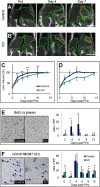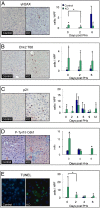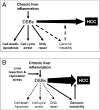Accelerated carcinogenesis following liver regeneration is associated with chronic inflammation-induced double-strand DNA breaks
- PMID: 20133864
- PMCID: PMC2836653
- DOI: 10.1073/pnas.0908867107
Accelerated carcinogenesis following liver regeneration is associated with chronic inflammation-induced double-strand DNA breaks
Abstract
Hepatocellular carcinoma (HCC) is the third leading cause of cancer mortality worldwide and is considered to be the outcome of chronic liver inflammation. Currently, the main treatment for HCC is surgical resection. However, survival rates are suboptimal partially because of tumor recurrence in the remaining liver. Our aim was to understand the molecular mechanisms linking liver regeneration under chronic inflammation to hepatic tumorigenesis. Mdr2-KO mice, a model of inflammation-associated cancer, underwent partial hepatectomy (PHx), which led to enhanced hepatocarcinogenesis. Moreover, liver regeneration in these mice was severely attenuated. We demonstrate the activation of the DNA damage-response machinery and increased genomic instability during early liver inflammatory stages resulting in hepatocyte apoptosis, cell-cycle arrest, and senescence and suggest their involvement in tumor growth acceleration subsequent to PHx. We propose that under the regenerative proliferative stress induced by liver resection, the genomic unstable hepatocytes generated during chronic inflammation escape senescence and apoptosis and reenter the cell cycle, triggering the enhanced tumorigenesis. Thus, we clarify the immediate and long-term contributions of the DNA damage response to HCC development and recurrence.
Conflict of interest statement
The authors declare no conflict of interest.
Figures





Similar articles
-
Interleukin 6-dependent genomic instability heralds accelerated carcinogenesis following liver regeneration on a background of chronic hepatitis.Hepatology. 2017 May;65(5):1600-1611. doi: 10.1002/hep.29004. Epub 2017 Mar 23. Hepatology. 2017. PMID: 28027584
-
Sorafenib treatment during partial hepatectomy reduces tumorgenesis in an inflammation-associated liver cancer model.Oncotarget. 2016 Jan 26;7(4):4860-70. doi: 10.18632/oncotarget.6638. Oncotarget. 2016. PMID: 26695439 Free PMC article.
-
p21 promotes sustained liver regeneration and hepatocarcinogenesis in chronic cholestatic liver injury.Gut. 2014 Sep;63(9):1501-12. doi: 10.1136/gutjnl-2013-304829. Epub 2013 Oct 3. Gut. 2014. PMID: 24092862
-
Lack of galectin-1 exacerbates chronic hepatitis, liver fibrosis, and carcinogenesis in murine hepatocellular carcinoma model.FASEB J. 2019 Jul;33(7):7995-8007. doi: 10.1096/fj.201900017R. Epub 2019 Mar 21. FASEB J. 2019. PMID: 30897344 Free PMC article.
-
Mouse liver tumorigenesis: models, mechanisms, and relevance to human disease.Semin Liver Dis. 1999;19(3):243-52. doi: 10.1055/s-2007-1007114. Semin Liver Dis. 1999. PMID: 10518304 Review.
Cited by
-
Increased expression of senescence markers in cystic fibrosis airways.Am J Physiol Lung Cell Mol Physiol. 2013 Mar 15;304(6):L394-400. doi: 10.1152/ajplung.00091.2012. Epub 2013 Jan 11. Am J Physiol Lung Cell Mol Physiol. 2013. PMID: 23316069 Free PMC article.
-
DNA double-strand breaks, potential targets for HBV integration.J Huazhong Univ Sci Technolog Med Sci. 2010 Jun;30(3):265-70. doi: 10.1007/s11596-010-0341-8. Epub 2010 Jun 17. J Huazhong Univ Sci Technolog Med Sci. 2010. PMID: 20556566
-
Transduction of fetal mice with a feline lentiviral vector induces liver tumors which exhibit an E2F activation signature.Mol Ther. 2014 Jan;22(1):59-68. doi: 10.1038/mt.2013.193. Epub 2013 Aug 28. Mol Ther. 2014. PMID: 23982166 Free PMC article.
-
Role of nonresolving inflammation in hepatocellular carcinoma development and progression.NPJ Precis Oncol. 2018 Feb 23;2(1):6. doi: 10.1038/s41698-018-0048-z. eCollection 2018. NPJ Precis Oncol. 2018. PMID: 29872724 Free PMC article. Review.
-
Function of TREM1 and TREM2 in Liver-Related Diseases.Cells. 2020 Dec 7;9(12):2626. doi: 10.3390/cells9122626. Cells. 2020. PMID: 33297569 Free PMC article. Review.
References
-
- Karin M, Greten FR. NF-kappaB: Linking inflammation and immunity to cancer development and progression. Nat Rev Immunol. 2005;5:749–759. - PubMed
-
- Mantovani A, Allavena P, Sica A, Balkwill F. Cancer-related inflammation. Nature. 2008;454:436–444. - PubMed
-
- Kundu JK, Surh YJ. Inflammation: Gearing the journey to cancer. Mutat Res. 2008;659:15–30. - PubMed
Publication types
MeSH terms
Substances
Associated data
- Actions
LinkOut - more resources
Full Text Sources
Other Literature Sources
Molecular Biology Databases
Research Materials

